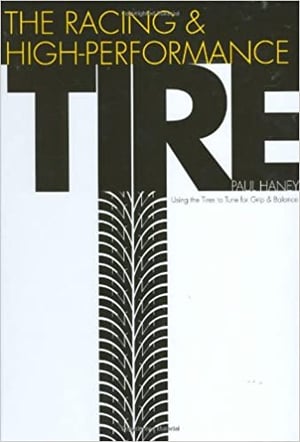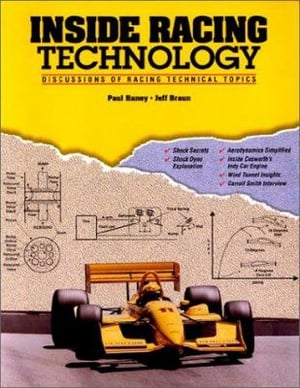Introduction
The best suspension components don’t guarantee optimal performance.
Optimization is specific to each individual’s situation; their vehicle, equipment, and driving style all matter. A driver or rider can bolt on high-end equipment, but optimization will remain elusive if they don’t know what their suspension components do and how they all work together.
Suspension tuning is a process, and there is no one-size-fits-all solution. There are too many variables at play, and driver feel is paramount.
There’s no shortcut to success. The drivers and riders who get the most out of their suspension tuning efforts are the ones who spend the most time on it. You can’t skip this work, and you can’t leapfrog this experience. The age-old thought of, “if I just buy what that guy has, I can be just as fast as him,” is just false and gets many racers frustrated. It's all about tuning the suspension to your specific feel and setup.
The first step in optimizing your suspension is genuinely understanding it. That’s why we compiled this guide to provide all the information you need to master the process of tuning your suspension and optimizing your vehicle’s performance.
What is Suspension Tuning?
Suspension tuning is the final piece of the puzzle when setting up your car or motorcycle. Instead of asking what it is, a better question is what is the goal of suspension tuning?
With a finely-tuned suspension, your tires will stay in contact with the road in any situation. Conversely, a poorly tuned suspension leads to handling problems, slow lap times, and poor performance.
Every racer wants more grip. They want better control and handling, faster lap times, and better performance. Enter suspension.
Want to learn more? Check out: Racing Shocks Explained in Less than 10 Minutes
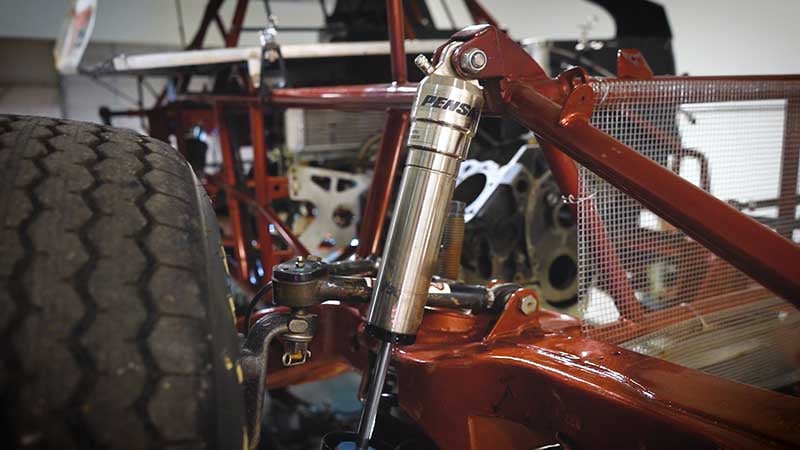
Suspension Components
A suspension comprises of tires, springs, and shocks that connect your vehicle to its wheels.
While many drivers give equal care and attention to the chassis, tires, brakes, and engine, you stand to gain the most performance improvement when focusing on your suspension.
A great example of this can be found in the Mazda Spec Miata platform, one of the most popular and competitive classes within the Sports Car Club of America and National Auto Sport Association. Mazda Motorsports upgraded the shocks on the Miata from under damped, street-based equipment to shocks more suited to a racing application. The result is a spec car with a finely tuned suspension.
Video of a Spec Miata on the shaker rig during testing of the Penske Racing Shocks product.
“The shocks allowed the tires to maintain more grip because the suspension worked properly, rather than constantly crashing down on the bump rubbers. With every car, driver, tire and track condition, the Penske (shock) provided superior control.”
- Randy Pobst, after testing the upgraded package.
Horsepower is essential, but an ill-handling car or bike can’t efficiently use it. Similarly, having the latest and most expensive shocks and suspension components doesn’t make a difference if you don’t understand how each part of your suspension works and what each adjustment does.
Now that we’re focused on suspension tuning, which components can be optimized? Before we show you, let's look at why you need to make adjustments.
What Impacts Suspension?
How does your car or bike feel on the track? Only you know how your vehicle handles.
Your team can collect data and make suggestions, but ultimately the buck stops with you.
- What is your goal for your suspension? Are you looking for better balance or more grip? What will make your experience or session successful? Lower lap times, a more comfortable ride, winning races?
- Does your car tend to oversteer on certain turns and understeer on others?
- What’s your balance and weight distribution?
- What are track conditions like?
You can only find out by testing and retesting. Preparation is key. Your experience at different tracks and under different weather conditions determine how you’ll set up over the race season. To level up your performance, be ready for anything.
Testing is especially critical for handling. You must be confident in how your vehicle reacts to your input when braking or changing direction.
Once you have an idea of what you want to change, you can start thinking about the adjustments you want to make.
Why Suspension Tuning is Important
We’ve highlighted that you stand to gain the most performance improvement when focusing on your suspension. Why is that?
If you understand each part of your suspension and what it's trying to do, you’ll quickly realize how important it is to prepare and finely tune.
Driver Preference
Every racer has a different style and preferences that determine their success on the track. Some racers prefer a soft suspension that swallows bumps and provides a smoother ride. Others prefer a stiff setup that’s less forgiving on rough tracks but minimizes body motion, making their vehicle feel more nimble and agile.
However, if your suspension is too stiff, you might experience a harsh or rigid feel. Conversely, if it’s too soft, you might feel unbalanced front to rear or lazy. The last thing you want is a bumpy ride and sluggish handling.
There is no right or wrong answer to which is best. Again, this is why driver feeling is so important. At the heart of this feeling is the piston. The curve characteristic is based on the piston design and is the heart of the shock. So, knowing what you like to feel will determine what piston you start with.
Track Conditions
If you record your baseline settings and any adjustments you make, you’re in an excellent position to tune for adverse race conditions without losing previous settings.
Smooth tracks alleviate fears of bottoming out, and you can set your suspension up to maintain low ground clearance. Wet weather could affect grip and tire traction. Dry weather might bring temperature changes and affect tire pressure.
There might be conditions on the track where you can make up more time. Setting up to absorb curbs might be sensible but will it make your lap times faster? You might be better off optimizing your suspension for mechanical grip and balance and avoiding curbs. This is where knowing the track and other conditions allows you to optimize your setup.
One more thing to consider with track conditions is the circuit itself. Is the circuit made up of tight corner sections and short straights? Or long, fast straights and fast, shallow corners? Suspension tuning based on driver preference and different track conditions is smart.
FREE DOWNLOAD - Damper Tuning Guide (Starter)
Ensuring a well-tuned damper setup can translate to significant performance gains on track. If you are unsure of where to begin the tuning process, this is a great starting point. Maximize the results of your shock adjustments with our free damper tuning guide download.
When You Should Focus on Suspension Tuning
Only you know how your car or bike feels. How it performs, holds the racing surface, and handles corners. Any changes to performance, a soft, spongy feeling, and uncharacteristic handling issues might mean you need to make adjustments. Don’t discount general maintenance either.
The ultimate goal in racing is to improve lap times continuously. Pre-season is a great time to optimize your suspension to start the season strong and confident in your vehicle. For example, when focused on geometry, you might dismantle the whole suspension to measure components in detail and inspect for any damage, no matter how big or small.
Pre-season is also a great time to get driver feedback and data without pressure and time constraints. The optimized setup can be validated on the racetrack through testing.
But you should always be looking for ways to optimize your performance and reduce lap times.
You’ll want to tune your suspension based on different tracks and weather conditions during the season, but you’ll also want to stay on top of wear and tear. For example, if your shocks are worn and need a rebuild, you’ll have to factor the rebuild into your season.
Want to learn more? Check out:
- 5 Risks of Not Doing a Shock Rebuild Before the Race Season
- 6 Things We All Hate About Rebuilding Racing Shocks
- 10 Ways To Completely Sabotage Your Race Car Setup
Before You Begin
With baseline suspension values, you'll have a reference to work off as you go.
Next, you’ll need the right tools. Not all these tools are necessary, but they will make your life easier. If you're racing on a budget and things like a data system are not practical, the NOTEBOOK is your biggest friend!
- Tire pressure gauge
- Tire pyrometer
- Toe plates with tape measures
- Data system for lap times (or a friend with a stopwatch)
- A notebook or binder to make notes. With this, you can also use our template for set-ups. Download it here for free.
- A history of settings so you can return to original settings if necessary
Think smart, not fast. Setting up for speed doesn’t make your car or bike the fastest if it’s at the expense of handling or grip in corners.
Break your handling down into sections. Most important is entry. If you're struggling on entry, the rest of the corner will be no good. After you're comfortable on entry, move to mid-corner or the apex, followed by the corner exit. Remember, any adjustment you make may affect another part of the corner or another part of the track. The key is to make changes that maximize your speed and reduce overall lap time.
Do you have the experience to tackle this on your own? If so, great. But if not, look for a partner that can help.
Suspension tuning is most effective when optimized for you and your preferences as a driver or rider.
The Penske S3 Program is dedicated to providing you with optimal hardware, personalized setup, and continued backend support.
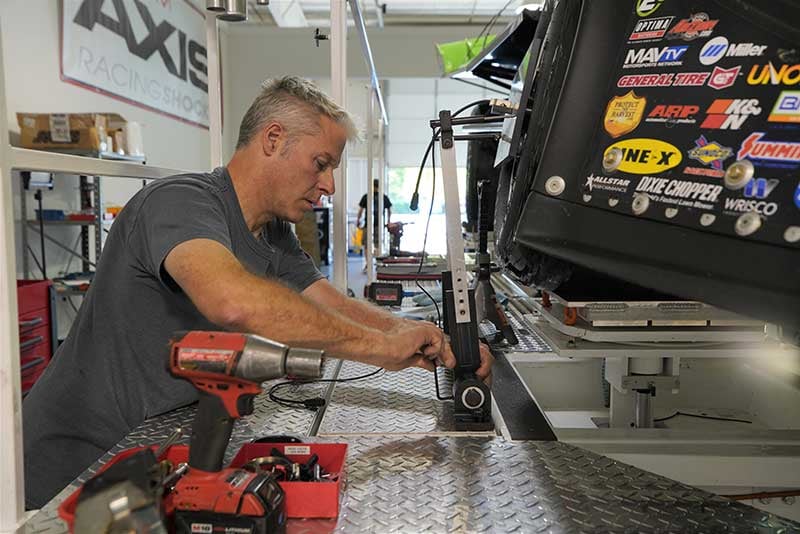
Geometry
The faster you drive or ride, the more downforce you generate. High speeds generate a considerable amount of downforce. Your suspension must be able to deal with the extra load. You face challenges in terms of the load the suspension carries and aerodynamically.
For aerodynamics, the position of the car relative to the track is critical. Raising or lowering the car changes the airflow dramatically, so the ride height must be well controlled.
When working with a bike, set your ride height before making adjustments. Ride height dramatically affects how you feel. Other components to consider before adjusting the meaty parts of your suspension are:
Sway Bar
A sway bar connects your right and left side compression. When you round a corner, the mass of your car shifts to the outside of the turn, causing the car to roll. By connecting both sides, the sway bar forces both ends of the axle to raise or lower to a similar height, preventing roll.
Sway bar diameter can significantly affect the balance of a car. Typically we see very stiff bars being used to help with platform and balance. The issue is that this masks the feel of what your shocks or even spring changes are doing. If you can maximize your shocks and springs, then use a smaller bar for support; this can typically help the overall platform and mechanical grip.
Camber, Caster, and Toe
Camber is the angle applied to the tires, and it alters the tires’ contact patch with the road. If the top of your wheels leans outwards, you have positive camber. When they lean in towards the car, it’s called negative camber.
Negative camber might increase cornering grip, but too much increases wear on the inside of the tire and cause handling imbalances like understeer. It is more predictable, though.
Caster, Camber, and Toe Angles are crucial elements for how a car feels on turn-in, as well as load transfer through the travel of the suspension. There is no perfect setting that covers all set-ups.
The proper angle feels best to the driver and is typically most consistent through the suspension's travel. Just be sure to measure it so you know where it's set, and be sure if you have an issue, to verify this hasn’t changed. You want to be sure to measure it through the travel of the suspension. This will have a great effect on the handling of the car at higher speeds.
Tire Pressure
Tires are an essential part of this equation. A new set of tires can bring any car to life, especially in racing. Making sure your tires' performance is repeatable is a must, things like pressure, stagger, and other characteristics of a tire will ensure you get accurate readings when you make changes.
A correctly inflated tire will maximize the contact patch, so it’s crucial to get it right. However, tire pressure is temperature-dependent.
What adjustments will you need to make on a hot day? How long is the session or race event? You might start with 25 psi, but after racing around a track 30 times, you might have 35 psi–make sure you consider this. How efficient your suspension is working will have a direct effect on tire temperature, and therefore tire wear. A more aggressive or stiff setup will lend itself to quicker and higher tire temps, and this might be desirable for qualifying or shorter stints. Where softer or more compliant suspensions are more gentle on the tires and may have a bigger advantage on long runs or a full race distance.
Suspension Tuning Components
Now that you know the why, when, and what, the next step is to think about the changes you can make to optimize your suspension.
Springs
Springs are a crucial part of your suspension setup. They are pretty important in determining how your car handles. They determine how close or far your chassis sits from the road or track. Adjusting the springs helps prevent bottoming out, limiting body roll when accelerating and cornering, and limiting nose-diving when braking.
Springs compress over bumps to absorb the force and then rebound to release the energy. Ideally, the spring compresses and rebounds at a precise rate.
What is the Ideal Spring Rate?
There are several variables when selecting the correct spring rate. The job of the spring is to support the vehicle. This can be done by preloading softer springs. The overall weight of the vehicle must be supported.
For example, if you need 500lbs x 4 corners to support a roughly 2000lb vehicle, you could just go with four 500lbs springs. Or, you could go with 250 lb springs and preload them two inches to give you 500lbs.
So the vehicle is supported, but the rate at which your springs travel is drastically different. There are many other factors like geometry and motion ratios, but you can see how there are multiple ways to tune just the spring rate.
Higher or Lower?
Higher rates are needed to reduce suspension motion, but also, if the aerodynamic load is increased, your spring rate has to compensate for that added load at higher speeds.
If sitting still, your vehicle produces zero pounds of downforce, but at 100mph, you might produce 500 pounds of downforce. Your setup must compensate for that increase in load at speed.
Softer rates are generally used if the platform feels too stiff or rigid. If you're feeling harshness over bumps or not getting enough travel out of your suspension, you can use softer rates.
There is no right or wrong regarding how much travel your suspension should use. It’s typically designed into the chassis. A popular aftermarket upgrade is to lower your ride height. When you do this, you go with a shorter but stiffer spring. The travel limit of the suspension is controlled by a mount on the chassis, a bump stop on the shock, or some other limiting device.
You don't want your tire in the wheel well to be your limiting factor, as this can be dangerous.
The goal is to have enough suspension travel to maximize your mechanical grip, but not so soft that the balance of the car or bike is not good. On the other hand, you don’t want to be so stiff that you overload your tires too quickly. This sacrifices grip as well, plus a suspension that is too stiff will feel rigid and is not very comfortable for the driver or rider.
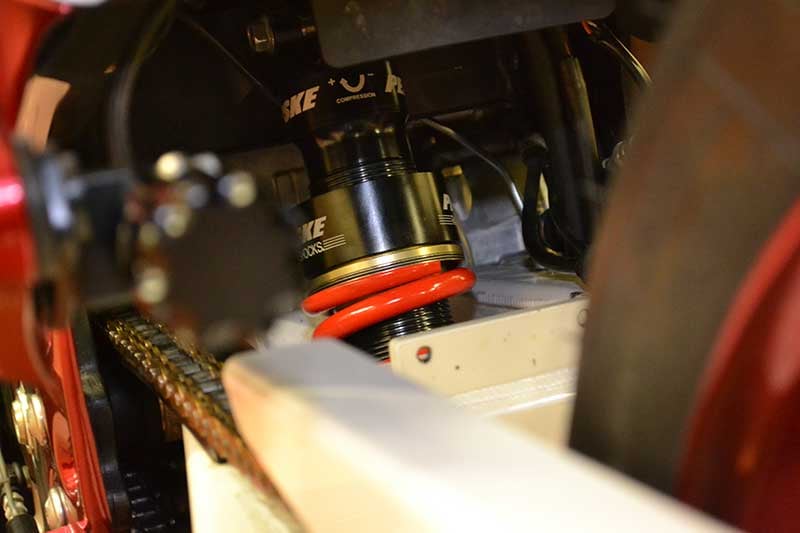
Shocks
Shocks are a critical component of your suspension setup. The main focus of a suspension is the shock absorber and spring package.
What is a shock absorber?
A shock absorber, sometimes called a damper, is a hydraulic device designed to absorb and damp shock impulses and reduce oscillations of your springs, allowing your tires to maintain traction.
How does it work?
The primary job is to control the speed your wheels move up and down. They achieve this by stopping your springs from compressing and rebounding too quickly, allowing for a better driving experience.
Compression and Rebound
As the shock compresses, oil flows from one side of the shock piston to the other. As oil flows through a piston with ports and shim stacks, it creates a damping force. This damping force is what you adjust to achieve different handling characteristics.
Once the shock compresses, the springs have stored energy that needs to dissipate. Rebound settings control that energy. Fluid flows from one side of the piston to the other.
You can adjust the shock rate when it compresses and rebounds, and each adjustment has an effect. Stiffer shock rates slow spring movements, while a softer shock allows the spring to move faster.
You can get granular and look at low-speed and high-speed compression for optimal performance.
Low-speed Compression
Gradual body roll or suspension changes, progressive power application, and applying the brakes are all smooth loads on the suspension. You can adjust the resistance to those movements and loads by increasing or decreasing low-speed compression.
Low-speed compression generally controls the platform, weight transfer, or roll of the chassis. This is the most sensitive part from a driver's standpoint. Typically, the low-speed range is from zero to three inches per second.
Let’s say you’re struggling with oversteer. As you enter a corner, if your rear feels light and wants to come around as weight shifts to the front of the car, you could increase low-speed front compression (as well as stiffening the front springs) to limit forward weight transference.
High-speed Compression
If you’re traveling down a smooth road at 80 mph, you’re still in the low-speed compression zone, but if you hit a bump, you might upset the vehicle. Enter high-speed compression.
You can adjust the resistance to those bumps by making your shocks stiffer. Some drivers and riders like a smoother ride, but most racers will sacrifice comfort for speed.
For Optimal Performance
Finding a balance between compression and rebound damping is the goal. Then a step farther is optimizing your low-speed and high-speed in both compression and rebound.
Multi-adjustable shocks make this optimization easy. They allow you to adjust compression and rebound independently. Furthermore, three and four-way adjustable shocks allow you to independently adjust low speed and high speed in compression and rebound.
What Effects Will Suspension Tuning Have?
Below are some common effects based on specific changes. This is a general list and not a specific tune for all cars.
Toe, Caster, and Camber are all suspension geometry settings that can be adjusted to suit driving style, tire wear, and overall performance. It is recommended that you get baseline settings from your chassis specialist, manufacturer, or chassis builder. Once you have a baseline, you can adjust these settings (plus or minus a few degrees). Below is a general guideline to what you might feel or how the chassis may react to changes.
Toe-in increases understeer, which is good for straight-line stability but makes turning slightly sluggish. Toe-out reduces understeer and increases grip. Excess toe-in or out can cause tire wear issues. If you feel you are seeing odd tire wear, we suggest you consult with your tire manufacturer.
Similar to Toe, positive and negative camber will affect tire wear and overall mechanical grip. In the front end, on turn in, this can cause an understeer or oversteer sensation. It will also affect tire wear. As mentioned above, if you feel you're seeing abnormal tire wear, we recommend speaking to your tire manufacturer. Make sure you have all your measurements so they can understand if your adjusted too far in one direction or the other.
Caster is typically a driver feel setting. It will affect your steering input response. Many drivers ignore or forget about the caster setting. It can be a very effective tuning tool.
Issues to Fix
Similar issues crop up for drivers and riders that we can address with tuning.
Oversteer and Understeer
There is no one area to focus on for steering issues. Generally, we address steering issues by optimizing the “balance” of handling.
If a car or bike has a good balance, it indicates an expected feel. A good balance feel means you will not be surprised or caught off guard by what your car or bike does. It's all about trust. Whether it's understeer or oversteer if you know what to expect and your car or bike does the same thing all the time, you can find the edge of performance easier, allowing you to tune more effectively. You’ll likely experiment with how much compression and rebound are optimal for better handling to adjust for steering issues.
The Vehicle is Too Stiff or Soft
If the balance feels off, your car or bike might be moving around too much because it’s too softly sprung. You can experiment with higher spring rates and shock adjustments.
Depending on what the characteristic or feel is to the driver will determine if you need to go stiffer or softer.
The Brakes Aren’t Stable
A car or bike that has a good balance does everything well. A stiff or soft feel will affect braking. It can cause premature wheel lockup under braking if you're too stiff on suspension. Likewise, when too soft, it can cause unwanted weight transfer that can overload the tires, causing lock up.
Poor Handling
This is a combination of everything above. Lack of confidence in your car or bike setup leads to poor performance.
Platform, braking, balance, and overall driver feel contribute to excellent handling. When your vehicle is over or underdamped and not controlling sudden inputs, it will knock your confidence in handling your car or bike. If you're not confident, it's hard to know how far you can go before you reach the limit of your suspension. That is why balance is so important. You will know where your limit is and be able to better tune so you can continue to push that limit.
Check out our ON-DEMAND WEBINAR: Top 10 Most Common Suspension Issues & How to Resolve Them
In this free webinar, we review the most common suspension issues you’re likely to encounter and tips for how you can resolve or avoid them altogether.
How Do You Pick the Right Components?
The most expensive components don’t guarantee performance, but the quality of your suspension setup is essential. In the modern era, parts are well made across the board, so your personal preference and style are the deciding factors.
Multi-adjustable shocks are generally more expensive, but if you don’t know how to use the adjusters, you're wasting your money. From a theoretical standpoint, fewer adjusters, fewer flow paths for fluid, and something like a non-adjustable shock can produce higher quality damping. 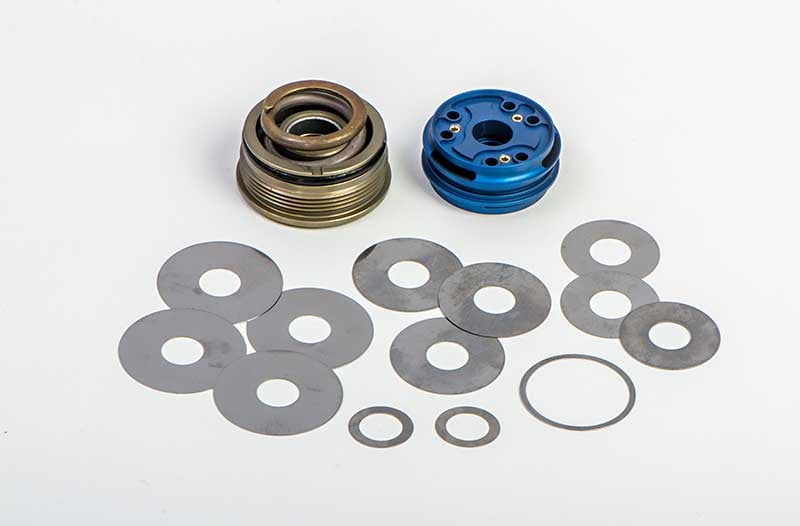
The problem with non-adjustable shocks? You need more of them, sometimes a lot more, to achieve what one multi-adjustable shock can do.
Of course, there are several quality components that show up in winning cars and bikes, so it’s worth making comparisons and working with trusted brands.
How Do You Pick the Right Partner?
Working with a manufacturer that specializes in suspension is a significant factor. Having an expert that you can call and bounce ideas off of or having someone keep you up to speed on all the latest developments will keep you developing and hopefully make your suspension better.
A manufacturer that deals with different suspension scenarios every day is like having an experienced crew chief or engineer on your team. If you don’t have this experience and support, it’s time-consuming and expensive to learn this stuff yourself.
To prevent buyer’s remorse and make the best investment, ask questions about a brand’s customer service, experience, results, and goals and expectations.
FREE DOWNLOAD: How to Read a Shock Dyno Graph
Anyone can tell you what your shocks' "performance" is, but a dyno graph will show you exactly what it is and how it compares to other shocks.
In this free download, we outline how to read a dyno graph and, more importantly, what it can tell you about how your shock is performing.
Results and Expectations
You want to test and try different setups that produce different results or feelings in the suspension. Sometimes a bad change or feeling is just as good as a positive change. Why? Because it’s all data, you can use it to understand better what your suspension wants.
The biggest mistake is setting expectations too high based on a specific change. We see it all too often that someone gets the “hot setup” or same shock as their faster buddy. You're not driving the car the same as your buddy or teammate most of the time. Therefore that “hot setup” or piece might not be the advantage or feel you were looking for.
Don’t give up. The goal should be to find out what feeling or part of that setup is different from yours. What did it do to your handling? What did you like or dislike about that change? Learn from it, and continue to develop it for your feel.
Remember, if the setup was based on science and math, everyone would eventually come to the same answer or solution. It's not that easy. Everyone has a different feel. Finding out how to get to that feeling quicker makes all the difference.
Tracking Your Progress
Ultimately, measuring success here will be easy. You will either be better on track, or you won’t. You also have to consider the process of getting there. Do you know why you’re going faster? Or did you just get lucky?
Data is essential; document everything to keep track of changes and how they impact performance.
Check out our FREE DOWNLOAD: Shock Build and Shock Setup/Lap Time Worksheet
In this free download, we provide both our Standard Shock Build Sheet, which is a great way to keep all your shock builds organized, and a Setup/Lap Time Sheet, a great tool to help improve your communication and record keeping of your chassis setup.
Maintaining set-up sheets for your test sessions or track days are essential. Make sure you have a basic checklist of settings:
- Shock Settings
- Tire Pressure
- Caster
- Camber
- Toe Settings
- Track Conditions
- Weather Conditions
These items are the basics of what should be found on a setup sheet. These common items should be checked weekly, daily, and sometimes before every session to ensure nothing has changed.
Even at the professional level, you will find mechanics or engineers who thought they had an “x”setting, when it was actually a “y” setting. So a pre-session check and post-session check of settings is a good practice.
More data is better than no data. Even if you don’t use it, maybe a future manufacturer or helper will find value in the data and better explain why a change worked or didn’t work.
Resources
Below are two great books written by some of the best in the business that introduce racing suspension and related parts. These are highly recommended books for learning more about tires, shocks, springs, and suspension design.
THE RACING & HIGH-PERFORMANCE TIRE
Using the Tires to Tune for Grip and Balance
by Paul Haney
INSIDE RACING TECHNOLOGY
Discussions of Racing Technical Topics
by Paul Haney and Jeff Braun
